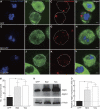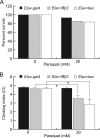Mitochondrial dysfunction and oxidative stress contribute to the pathogenesis of spinocerebellar ataxia type 12 (SCA12)
- PMID: 21471219
- PMCID: PMC3122230
- DOI: 10.1074/jbc.M110.160697
Mitochondrial dysfunction and oxidative stress contribute to the pathogenesis of spinocerebellar ataxia type 12 (SCA12)
Abstract
Spinal cerebellar ataxia type 12 (SCA12) has been attributed to the elevated expression of ppp2r2b. To better elucidate the pathomechanism of the neuronal disorder and to search for a pharmacological treatment, Drosophila models of SCA12 were generated by overexpression of a human ppp2r2b and its Drosophila homolog tws. Ectopic expression of ppp2r2b or tws caused various pathological features, including neurodegeneration, apoptosis, and shortened life span. More detailed analysis revealed that elevated ppp2r2b and tws induced fission of mitochondria accompanied by increases in cytosolic reactive oxygen species (ROS), cytochrome c, and caspase 3 activity. Transmission electron microscopy revealed that fragmented mitochondria with disrupted cristae were engulfed by autophagosomes in photoreceptor neurons of flies overexpressing tws. Additionally, transgenic flies were more susceptible to oxidative injury induced by paraquat. By contrast, ectopic Drosophila Sod2 expression and antioxidant treatment reduced ROS and caspase 3 activity and extended the life span of the SCA12 fly model. In summary, our study demonstrates that oxidative stress induced by mitochondrial dysfunction plays a causal role in SCA12, and reduction of ROS is a potential therapeutic intervention for this neuropathy.
Figures







References
-
- Dueñas A. M., Goold R., Giunti P. (2006) Brain 129, 1357–1370 - PubMed
-
- Manto M., Marmolino D. (2009) Curr. Opin. Neurol. 22, 419–429 - PubMed
-
- Trujillo-Martín M. M., Serrano-Aguilar P., Monton-Alvarez F., Carrillo-Fumero R. (2009) Mov. Disord. 24, 1111–1124 - PubMed
-
- Holmes S. E., Hearn E. O., Ross C. A., Margolis R. L. (2001) Brain Res. Bull. 56, 397–403 - PubMed
-
- Holmes S. E., O'Hearn E., Margolis R. L. (2003) Cytogenet. Genome Res. 100, 189–197 - PubMed
Publication types
MeSH terms
Substances
LinkOut - more resources
Full Text Sources
Other Literature Sources
Molecular Biology Databases
Research Materials

